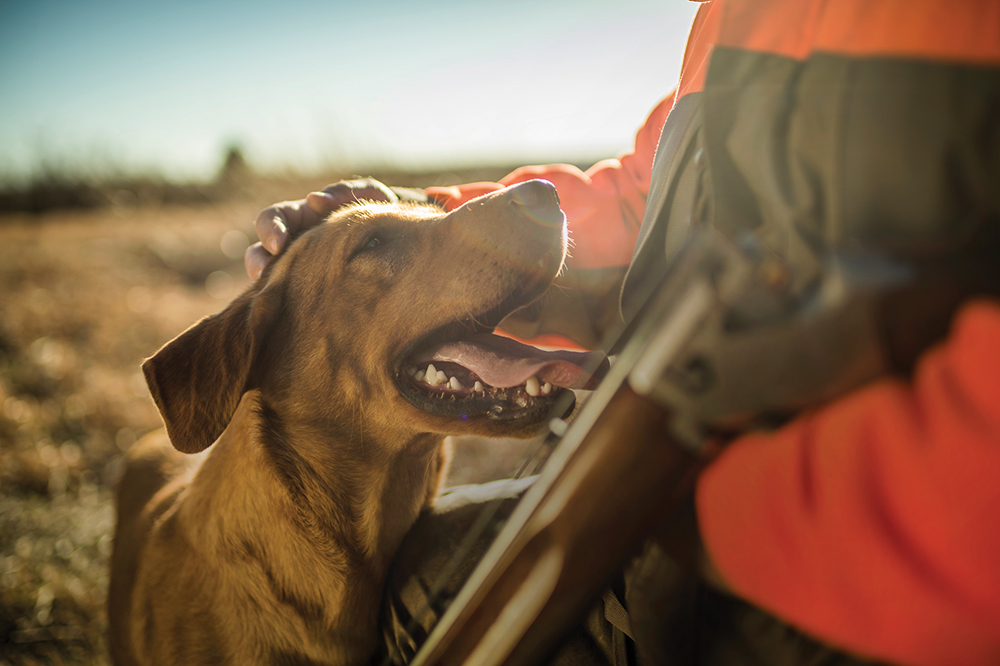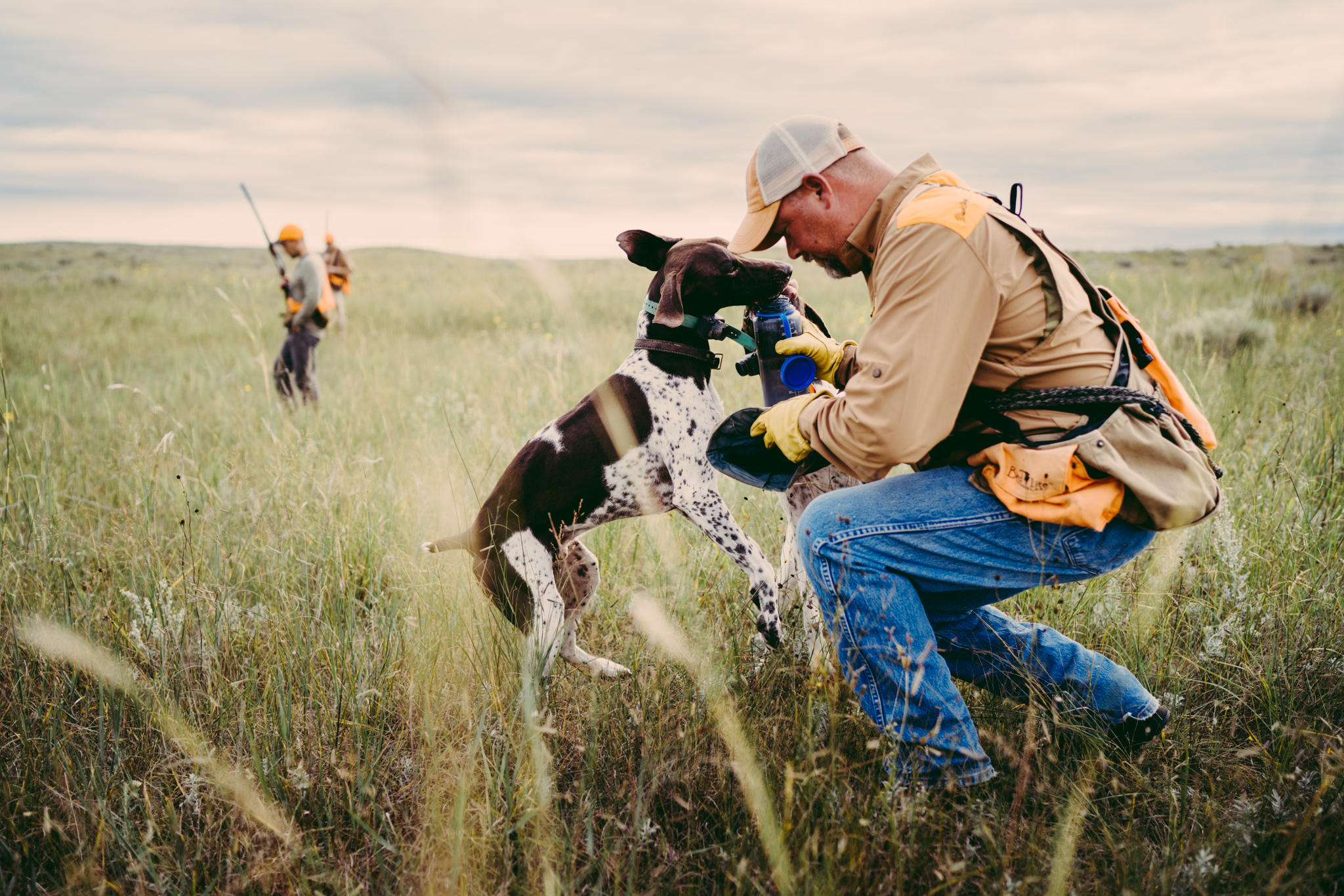Canine Concerns: Hunting dogs face risks most house pets will never encounter.

Hunting dogs are athletes required to perform in all kinds of weather and are exposed to environmental hazards rarely found in a backyard. Further, many hunting dogs have a drive so strong it overrides discomfort. They may not immediately display symptoms of something potentially lethal—which means their mortality clock may already be ticking toward alarm when you discover the problem.
External injuries such as severe lacerations, gunshots, and broken bones need obvious attention. They can be treated in the field and are (usually) not life-threatening. On the other hand, the early stages of GDV, hypothermia, poisoning, heat stroke, and hypoglycemia start with symptoms that don’t look particularly threatening but can kill a dog more quickly than most of us realize. For example, dogs experiencing bloat and stomach torsion may have as little as 20 minutes to an hour before going into shock and losing consciousness. Hypothermia sets in when a dog’s body temperature drops below 100 degrees from its normal 101 to 102.5 degrees—just a drop of 2 or 3 degrees is enough. The neurotoxin in blue-green algae can cause death within minutes. On an 85-degree day, the cab of a parked truck reaches 120 degrees in 30 minutes, with heatstroke occurring once the dog’s body temperature hits 109 degrees.
As hunters, we put our dogs in rigorous and demanding situations, far from veterinary care. A day’s hike into the backcountry, a bush plane’s flight across the tundra, even the remote seclusion of hunting camp all mean we’re a long way from an emergency vet and need many hours to get there. Loving our bird dogs as we do, we owe it to them to recognize the signs of life-threatening conditions and to learn how to treat them (when we can). In this article, we’ll look at bloat and torsion, and hypoglycemia.

Bloat and Torsion
Numbers tell stories that lead to life-saving information; personal accounts provide background. For example, one summer evening when I was out in the field playing fetch with Scratch, my deep-chested German shorthair, he suddenly walked away, clearly trying to throw up. He was obviously uncomfortable, hunched up, and couldn’t produce vomit. He looked as if he had swallowed a basketball—and he felt like it: Four hours after he last ate, his stomach was bloated and drum-hard. I recognized these as symptoms of bloat and torsion (technically, GDV—gastric dilation and volvulus) because my husband’s wirehair, Scrub, had it happen seven years previously. I knew the signs and knew what to do—get to a vet.
Dogs can bloat without the stomach twisting; but when twisting occurs, the dog can die within hours. Blood supply in and out of the stomach is cut off, resulting in a severe drop in blood pressure and damage to internal organs. When my husband’s dog Scrub bloated, we got to the emergency clinic within an hour, but mild shock had already set in. They took Scrub into surgery immediately. Collateral damage wasn’t too bad yet. His spleen had to be removed and the surgeon performed a gastropexy, suturing the stomach to the body wall, preventing it from rotating should Scrub bloat again. A week after Scratch’s GDV, he too had gastropexy surgery because once a dog bloats, it is likely to recur.
Despite an enormous amount of study, no one knows conclusively why bloat and torsion happen. Genetics and body type appear to be factors. Dogs with very deep chests like Scratch are higher-risk candidates. “Gassy” dogs are more prone to bloat. Precautions include feeding the dog two to three times a day instead of once, withholding water for a while after meals, waiting an hour after exercise to feed, and waiting one to two hours after feeding before allowing exercise.
What to look for: Symptoms of GDV include a hard, distended stomach; unsuccessful belching or attempts to vomit; weakness; excessive salivation; rapid breathing and pale gums; intense abdominal pain; and collapse.
What you can do: With GDV, shock and loss of consciousness can occur in the dog in as little as 20 minutes to an hour. Getting to a vet immediately is critical. If your dog bloats and you are hours from veterinary care, there are two emergency ways to relieve the gas. One is to insert a flexible tube down the dog’s throat; instructions are available online. The other is to insert a #14 needle on the left side about 1.5 to 2 inches behind the ribs, aiming downward and toward the head. This is considered quicker and safer than using the tube. These procedures may relieve the gas, but if the stomach has flipped, they simply buy some time to get the dog to a vet by relieving some of pressure on the internal organs. Immediate surgery will still be necessary.

Hypoglycemia
Joe Healy, former editor of Covey Rise remembers the first time his English pointer, Reilly, had a low-blood-sugar episode. They’d been grouse hunting for about two hours when he took a break and noticed she had a vacant look in her eyes.
“She looked like she was zoning out,” Joe recalls. “She started to teeter unsteadily on her feet, and then literally tipped over and collapsed to the ground.” Reilly had mild convulsions at that point, and Joe didn’t know what was happening, just that his dog was unwell. He gave her water and sat with her. After about 10 minutes, she looked at him and was clear-eyed. He called it a day. With rest and then food, she was fine. After talking with his vet, Joe learned his dog likely had a blood-sugar crash.
Although it turned out that Reilly had a genetic propensity for low-blood-sugar events (hypoglycemia), it rarely occurred more than once a season. Joe further learned from an experienced bird-hunting partner to carry sugary treats in his hunting vest, in Joe’s case rice cakes soaked in corn syrup and stashed in a Ziploc baggie. Recognizing the symptoms, Joe knew an onset was imminent and would feed Reilly a sweetened rice cake, which would quickly bring her sugar level back to normal.
Hunting dogs (those not diabetic or with Addison’s disease) can develop hypoglycemia after extended hard exertion depletes their liver glycogen. The condition is often referred to as “exertional hypoglycemia” or even “hunting-dog hypoglycemia.” The episodes occur in healthy dogs when, for some reason, the dog’s liver glycogen reserves are not sufficient to keep up the normal blood-glucose levels when the dog is hunting or exercising for a period of time. As Joe explained about Reilly, she never had a low-sugar episode when she wasn’t hunting or running in the woods, and the vets could find nothing related to her diet or the weather. Episodes occurred in warm or chilly temperatures.
The symptoms of hypoglycemia include fatigue, lack of coordination, lethargy, trembling or muscle spasms, discoloration of the skin and gums, unwillingness to eat or drink, dilated pupils, seizures, and stupor or collapse. The best course of action is to give the dog a simple sugar. Some people carry a 50 percent mix water-glucose solution; others keep corn syrup or honey in their game vests. Pouring syrup or honey into the dog’s mouth could cause choking but rubbing it on their gums or under the tongue with your finger is safe.
However, if the dog starts to have tremors or muscle spasms (even after having some kind of glucose), get the dog to a vet right away. Once seizures or prolonged convulsions set in, asphyxia is possible because of the difficulty breathing. Fortunately, most dogs like Reilly respond and recover quickly. Joe says that she’d be back to normal in minutes and would go back to work, doing what she was bred to do. Sadly, Reilly developed lymphoma at age 8 and died six months later. (Joe wrote a book about what he learned during her training, called Training A Young Pointer, published by Stackpole Books www.stackpolebooks.com.) Unfortunately, as with humans, there is no panacea for canine cancer.
























